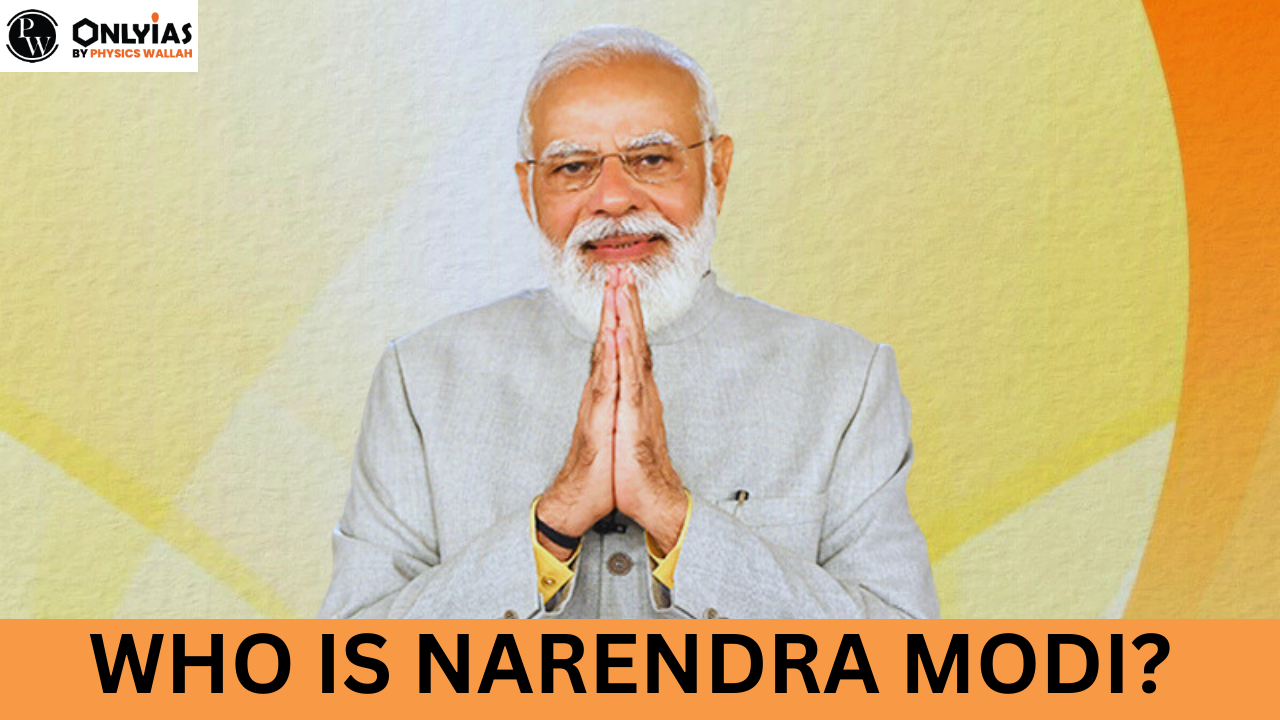
Prime Minister Narendra Modi Biography: Narendra Modi, the current Prime Minister of India, has had a significant impact on Indian politics and governance. PM Modi Birthday is celebrated on September 17. He was born in 1950, in Vadnagar, Gujarat, Modi rose from humble beginnings to become a key political figure. He holds a degree in Political Science and has been an active member of the Rashtriya Swayamsevak Sangh (RSS). Known for his dynamic leadership and development-focused agenda, Modi’s political journey has been marked by his tenure as Chief Minister of Gujarat and his subsequent rise to the national stage. Get complete details on Prime Minister Narendra Modi here:
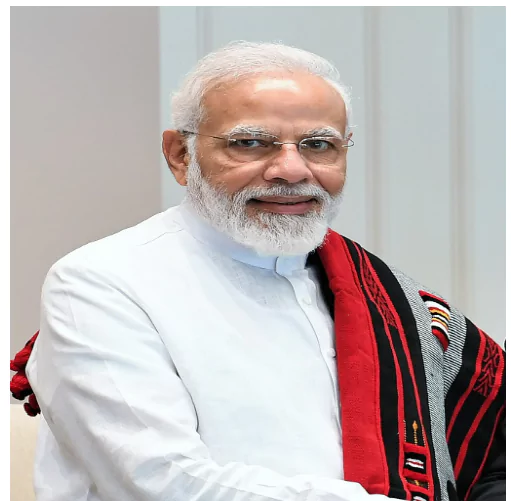
Narendra Modi Picture
Narendra Modi, (full name, Narendra Damodardas Modi), the 14th Prime Minister of India, is a charismatic and influential leader who has left an indelible mark on the nation’s political landscape. Born on September 17, 1950, in Vadnagar, a small town in Gujarat, Modi’s journey to the pinnacle of Indian politics is a remarkable tale of perseverance, determination, and astute leadership.
Narendra Modi Biography |
|
| Narendra Modi Full Name | Narendra Damodardas Modi |
| Born (Narendra Modi Birthday) | 17 September, 1950 |
| Mother | Heeraben Modi |
| Father | Damodardas Modi |
| Place of Birth | Vadnagar, Mehsana (Gujarat) |
| Zodiac Sign | Virgo |
| Nationality | Indian |
| Age | 74 years (Prime Minister Narendra Modi turned 74 on September 17, 2024). |
| Pm Modi Political Party | Bharatiya Janata Party (BJP) |
The full name of Narendra Modi is Narendra Damodardas Modi, is recognized by various names that shows the different aspects of his personality and roles. He is commonly referred to as NaMo, a widely used abbreviation derived from the first two letters of his first and last names, signifying a sense of familiarity and closeness. Various other names of narendra Modi has been recognised as:
In Vadnagar, Mehsana district, Bombay State (current-day Gujarat), Narendra Damodardas Modi in 1950, to a Gujarati Hindu family of grocery store owners. PM Modi birthday is celebrated on September 17. He was the third child to be born to Hiraben and Damodardas Mulchand Modi.
Narendra Modi, the present serving Prime Minister of India, was born on September 17, 1950. At present, in 2024, Narendra Modi age is 74. Throughout his political career, Modi has been a significant figure, known for his leadership, vision, and constructive policies. His journey from humble beginnings to the highest office in the country has been marked by both praise and criticism, shaping the political landscape of India.
Modi was born into a humble family. His father, Damodardas Mulchand Modi, ran a tea stall, and his mother, Hiraben, was a homemaker. Despite the financial challenges they faced, Modi’s parents instilled in him strong values and a passion for knowledge. From an early age, Modi showed an inclination towards public speaking and debating. Narendra Modi birth place was Vadnagar, a small town in the Mehsana district of Gujarat, India.
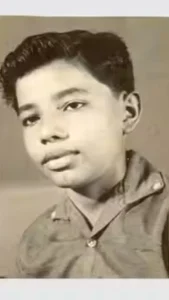
After completing his higher secondary education, Modi pursued a Bachelor’s degree in Political Science from the University of Delhi. During this time, he actively participated in student politics, which fueled his ambition to serve the nation.
Narendra Modi, the former Prime Minister of India, has a relatively small and close-knit family. Mother’s name of Narendra Modi was Heeraben Modi, born in 1920 and died in 2022. She was a homemaker, while Damodardas Mulchand Modi (1915-1989) was a small-time grocer and tea seller. He also has four brothers named Soma, Prahlad, Pankaj, and Amrut, who lead relatively private lives, distinct from his own path in politics.
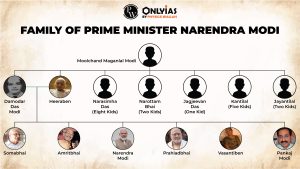
Narendra Modi’s mother’s name is Heeraben Modi. Born in 1923, she has been a significant influence in his life, embodying simplicity and strong values. Heeraben has often been mentioned by Modi in his speeches and writings as a source of inspiration and strength. She lives in Gujarat, and despite her advanced age, she has remained an important figure in Modi’s personal life, symbolizing the traditional Indian values of hard work and humility. She passed away on 30 December 2022 (age 99 years) in Ahmedabad.
Narendra Modi, the Prime Minister of India, was married to Jashodaben Narendrabhai Modi. However, it’s important to note that Narendra Modi and Jashodaben have been estranged for many years and have lived separately since their marriage. Narendra Modi publicly acknowledged his marital status in 2014 during his election campaign.
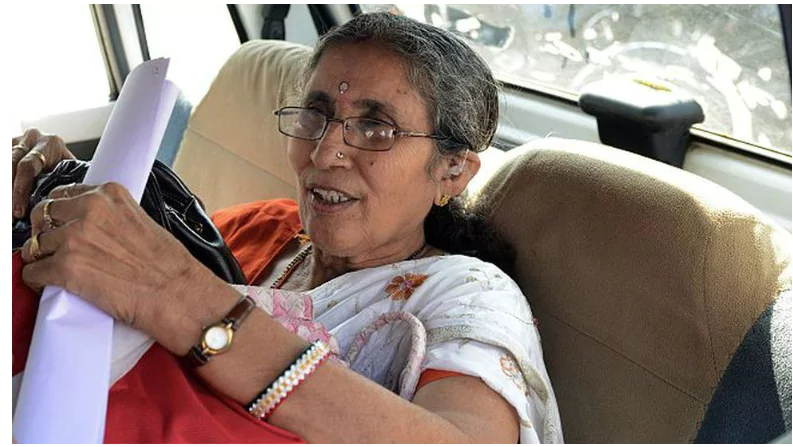
Jasodaben, wife of Narendra Modi
After finishing his secondary education, Narendra Modi earned a bachelor’s degree in Political Science from Delhi University. His academic journey continued as he pursued a Master of Arts degree in Political Science from Gujarat University.
Narendra Modi represents the Varanasi constituency in the Lok Sabha, the lower house of the Parliament of India. He has been elected from this constituency in multiple general elections, including the most recent ones.
Prior to the 2014 Lok Sabha elections, Modi was designated the BJP’s prime ministerial candidate in September 2013. Several BJP stalwarts, including BJP founding member L. K. Advani, expressed opposition to Modi’s candidature, citing concerns about those who were “concerned with their personal agendas”. In the BJP’s 2009 general election campaign, Modi was a key player. Many BJP supporters claimed they would have chosen a different party if Modi had not been the prime ministerial candidate. Unusual for a BJP electoral campaign, Modi was the focal point. Narendra Modi was the subject of a referendum during the election.
In 2014, Narendra Modi led the Bharatiya Janata Party (BJP) to a resounding victory in the general elections, securing an absolute majority in the Lok Sabha (lower house of parliament). This victory propelled him to the position of India’s Prime Minister.
As Prime Minister, Modi launched ambitious initiatives aimed at transforming India. The flagship program, “Make in India,” focused on promoting manufacturing and boosting job creation. “Digital India” aimed to harness technology for the country’s progress, while “Skill India” aimed to enhance the employability of the Indian workforce.
Another significant initiative was the implementation of the Goods and Services Tax (GST), a unified tax system that streamlined India’s complex tax structure. Additionally, Modi launched the Swachh Bharat Abhiyan (Clean India Campaign) to promote cleanliness and sanitation across the country.
Modi was announced as the BJP’s nominee for prime minister in the 2019 general election on October 13, 2018. Amit Shah, the BJP’s president, led the party’s political campaign. As a candidate for Varanasi in the Lok Sabha election, Modi defeated Shalini Yadav of the Samajwadi Party (SP), who ran as a candidate for the SP-BSP coalition, by a margin of 479,505 votes. The National Democratic Alliance, which won the election with 353 members in the Lok Sabha (the BJP won 303 seats alone), overwhelmingly chose Modi to serve as prime minister for a second term.
Under Modi’s leadership, India’s foreign policy underwent a significant shift. He initiated numerous international visits, strengthening India’s relationships with key nations worldwide. Modi’s diplomacy emphasized economic cooperation, strategic partnerships, and cultural exchanges.
Notably, he played a crucial role in addressing climate change by championing the International Solar Alliance. He also took proactive measures to enhance India’s presence on the global stage, advocating for India’s permanent membership in the United Nations Security Council.
Under Modi, India’s nominal military spending grew steadily. The military budget shrank under Modi’s leadership, both as a percentage of GDP and after inflation. The military budget was heavily weighted towards human costs. Commentators claimed that the budget was preventing India from modernising its military.
The Ministry of Environment and Forests was renamed to the “Ministry of Environment, Forests, and Climate Change” when Modi named his cabinet, and its funding in the first budget of his government was more than half. A number of legislation pertaining to environmental protection and others pertaining to industrial activities were deleted or weakened by the new ministry. Additionally, the government attempted to dissolve the National Board for Wildlife in order to remove NGOs’ representatives, but the Supreme Court of India blocked this effort.
Prime Minister Narendra Modi has authored several books and written extensively on various subjects, including his experiences, thoughts, and vision for India. Here are some of the books authored by him:
“Convenient Action: Gujarat’s Response to Challenges of Climate Change” (2011): In this book, Narendra Modi discusses Gujarat’s efforts in addressing climate change and environmental challenges during his tenure as the Chief Minister of the state.
Jyotipunj (2014): “Jyotipunj” is a collection of profiles and biographical sketches of sixteen social and political leaders who inspired Narendra Modi. The book provides insights into the lives and contributions of these leaders.
Exam Warriors (2018): “Exam Warriors” is a book aimed at students, particularly those preparing for exams. In this book, Modi offers advice, guidance, and tips for managing stress and performing well in exams. It includes interactive activities and illustrations.
Mann Ki Baat: A Social Revolution on Radio” (2019): This book is a compilation of Prime Minister Modi’s radio addresses, known as “Mann Ki Baat.” In these broadcasts, he shares his thoughts on various topics and connects with the citizens of India.
Letters to Mother (2019): This book contains a collection of letters written by Narendra Modi to his mother, Heeraben Modi. These letters provide a personal and emotional insight into his life, experiences, and thoughts.
A Journey: Poems by Narendra Modi (2019): In this collection of poems, Narendra Modi reflects on various aspects of life, including nature, spirituality, and patriotism. The book showcases his literary side and poetic expression.
According to the most recent information available on PM Modi’s website, his net worth has increased this year compared to last year. In accordance with his most recent disclosure, Prime Minister Modi’s net worth increased from 2.85 crore last year to 3,07,68,885 (3.07 crore). In the past year, his net worth has climbed by 22 lakh rupees.
As of March 31, the 71-year-old prime leader had 1,52,480 in his bank account and 36,900 in cash. His increased fortune is a result of his fixed deposits in a State Bank of India branch in Gandhinagar. As of March 31 this year, his fixed deposits (FD) with the SBI Gandhinagar NSC branch were 1.83 crore, up from 1.6 crore the previous year.
Narendra Modi, serving as the Prime Minister of India since 2014, has been associated with several major achievements and decisions during his tenure:
Indian Prime Minister Narendra Modi implemented demonetization, the elimination of high-value banknotes, with the aim of stimulating the economy and bringing the shadow economy into the formal sector. After December 31, 2016, both 500 and 1,000 rupee notes lost their legal tender status.
The Goods and Services Tax (GST) bill, introduced by the Modi administration, replaced more than a dozen federal and state levies over seventy years since India’s independence. This move increased government revenue by bringing millions of firms into the tax system. Businesses are required to upload invoices to a website for tax compliance, and companies without tax identification numbers risk losing clients.
The Modi government proposed splitting the state of Jammu and Kashmir into two union territories, Jammu and Kashmir, and Ladakh, while also repealing Article 370, which granted special status to Jammu and Kashmir. This change allowed foreigners to purchase real estate in Jammu and Kashmir and opened state government positions and some college admissions to non-state residents.
The Modi government passed the Citizenship Amendment Act (CAA), which facilitates the acquisition of Indian citizenship by persecuted non-Muslim minorities from Pakistan, Bangladesh, and Afghanistan. However, this act sparked protests across the nation due to its controversial nature.
The triple talaq bill, approved by Parliament and signed into law by President Ram Nath Kovind, criminalized the practice of instant divorce by Muslim men. The Muslim Women (Protection of Rights on Marriage) Act, 2019, declared such forms of divorce null and unlawful, making it illegal to utter “talaq” three times in a row, whether verbally, in writing, via SMS, WhatsApp, or other electronic communication apps.
The Digital India initiative aimed to transform India into a digitally empowered society and knowledge economy. It focused on improving digital infrastructure, e-governance, and digital literacy.
This campaign was launched to promote manufacturing and boost job creation within India. It aimed to attract foreign investment and make India a global manufacturing hub.
This nationwide cleanliness drive sought to improve sanitation and hygiene across the country. It included building toilets, promoting cleanliness, and raising awareness about the importance of sanitation.
The Pradhan Mantri Jan Dhan Yojana was launched to promote financial inclusion by providing access to banking services to the unbanked and underbanked population.
The implementation of the GST was a significant economic reform. It aimed to simplify the taxation system by replacing multiple taxes with a single nationwide tax.
India conducted surgical strikes in response to terrorist attacks, particularly the Uri attack in 2016. These strikes were seen as a strong response to cross-border terrorism.
Narendra Modi worked on strengthening India’s relationships with several countries, including the United States, Russia, Israel, and neighboring nations like Bangladesh and Nepal.
During the COVID-19 pandemic, the Indian government under Modi launched the Aatmanirbhar Bharat Abhiyan (Self-Reliant India Mission) to support the economy during the crisis.
The Supreme Court’s decision allowing Hindus to build a temple in Ayodhya, the birthplace of Lord Ram, marked the end of long-standing legal battles. Prime Minister Narendra Modi initiated the construction of the temple, fulfilling a decades-old promise of his Bharatiya Janata Party (BJP) by placing a plaque at the temple site in a grand ceremony.
Prime Minister Narendra Modi Major Decisions and Schemes
Here is a list of major areas where Narendra Modi’s government has implemented significant initiatives and schemes:
Modi’s foray into politics began with the Rashtriya Swayamsevak Sangh (RSS), a right-wing Hindu nationalist organization. He dedicated himself to the RSS and quickly rose through its ranks, honing his leadership skills and gaining a deep understanding of grassroots politics.
In 2001, Modi became the Chief Minister of Gujarat, a state in western India. His tenure as Chief Minister was marked by his emphasis on development and efficient governance. Under his leadership, Gujarat witnessed significant economic growth, infrastructure development, and improvements in various social indicators.
Sign up for the PWOnlyIAS Online Course by Physics Wallah and start your journey to IAS success today!
| Related Links | |
| Netaji Subhash Chandra Bose Biography | Sarvepalli Radhakrishnan Biography |
| Jawaharlal Nehru Biography | Rabindranath Tagore Biography |
| Mahatma Gandhi Biography | |
| Must Read | |
| NCERT Notes For UPSC | UPSC Daily Current Affairs |
| UPSC Blogs | UPSC Daily Editorials |
| Daily Current Affairs Quiz | Daily Main Answer Writing |
| UPSC Mains Previous Year Papers | UPSC Test Series 2024 |
<div class="new-fform">
</div>
